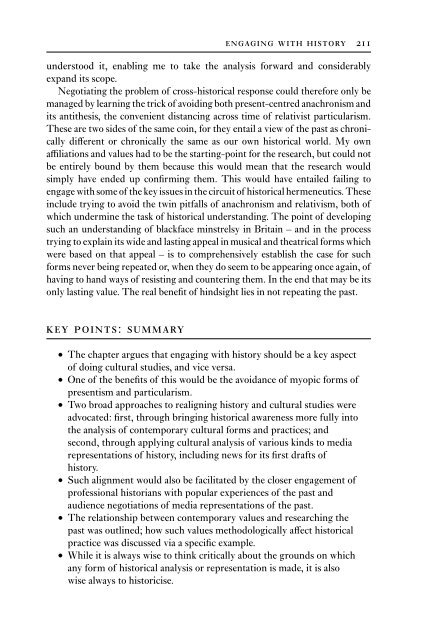Michael Pickering-Research Methods in Cultural Studies (Research Methods for the Arts and Humanities) (2008)
Create successful ePaper yourself
Turn your PDF publications into a flip-book with our unique Google optimized e-Paper software.
ENGAGING WITH HISTORY 211<br />
understood it, enabl<strong>in</strong>g me to take <strong>the</strong> analysis <strong>for</strong>ward <strong>and</strong> considerably<br />
exp<strong>and</strong> its scope.<br />
Negotiat<strong>in</strong>g <strong>the</strong> problem of cross-historical response could <strong>the</strong>re<strong>for</strong>e only be<br />
managed by learn<strong>in</strong>g <strong>the</strong> trick of avoid<strong>in</strong>g both present-centred anachronism <strong>and</strong><br />
its anti<strong>the</strong>sis, <strong>the</strong> convenient distanc<strong>in</strong>g across time of relativist particularism.<br />
These are two sides of <strong>the</strong> same co<strong>in</strong>, <strong>for</strong> <strong>the</strong>y entail a view of <strong>the</strong> past as chronically<br />
different or chronically <strong>the</strong> same as our own historical world. My own<br />
affiliations <strong>and</strong> values had to be <strong>the</strong> start<strong>in</strong>g-po<strong>in</strong>t <strong>for</strong> <strong>the</strong> research, but could not<br />
be entirely bound by <strong>the</strong>m because this would mean that <strong>the</strong> research would<br />
simply have ended up confirm<strong>in</strong>g <strong>the</strong>m. This would have entailed fail<strong>in</strong>g to<br />
engage with some of <strong>the</strong> key issues <strong>in</strong> <strong>the</strong> circuit of historical hermeneutics. These<br />
<strong>in</strong>clude try<strong>in</strong>g to avoid <strong>the</strong> tw<strong>in</strong> pitfalls of anachronism <strong>and</strong> relativism, both of<br />
which underm<strong>in</strong>e <strong>the</strong> task of historical underst<strong>and</strong><strong>in</strong>g. The po<strong>in</strong>t of develop<strong>in</strong>g<br />
such an underst<strong>and</strong><strong>in</strong>g of blackface m<strong>in</strong>strelsy <strong>in</strong> Brita<strong>in</strong> – <strong>and</strong> <strong>in</strong> <strong>the</strong> process<br />
try<strong>in</strong>g to expla<strong>in</strong> its wide <strong>and</strong> last<strong>in</strong>g appeal <strong>in</strong> musical <strong>and</strong> <strong>the</strong>atrical <strong>for</strong>ms which<br />
were based on that appeal – is to comprehensively establish <strong>the</strong> case <strong>for</strong> such<br />
<strong>for</strong>msnever be<strong>in</strong>g repeated or, when <strong>the</strong>y do seem to be appear<strong>in</strong>g once aga<strong>in</strong>, of<br />
hav<strong>in</strong>g to h<strong>and</strong> ways of resist<strong>in</strong>g <strong>and</strong> counter<strong>in</strong>g <strong>the</strong>m. In <strong>the</strong> end that may be its<br />
only last<strong>in</strong>g value. The real benefitofh<strong>in</strong>dsight lies <strong>in</strong> not repeat<strong>in</strong>g <strong>the</strong> past.<br />
KEY POINTS: SUMMARY<br />
• The chapter argues that engag<strong>in</strong>g with history should be a key aspect<br />
of do<strong>in</strong>g cultural studies, <strong>and</strong> vice versa.<br />
• One of <strong>the</strong> benefits of this would be <strong>the</strong> avoidance of myopic <strong>for</strong>ms of<br />
presentism <strong>and</strong> particularism.<br />
• Two broad approaches to realign<strong>in</strong>g history <strong>and</strong> cultural studies were<br />
advocated: first, through br<strong>in</strong>g<strong>in</strong>g historical awareness more fully <strong>in</strong>to<br />
<strong>the</strong> analysis of contemporary cultural <strong>for</strong>ms <strong>and</strong> practices; <strong>and</strong><br />
second, through apply<strong>in</strong>g cultural analysis of various k<strong>in</strong>ds to media<br />
representations of history, <strong>in</strong>clud<strong>in</strong>g news <strong>for</strong> its first drafts of<br />
history.<br />
• Such alignment would also be facilitated by <strong>the</strong> closer engagement of<br />
professional historians with popular experiences of <strong>the</strong> past <strong>and</strong><br />
audience negotiations of media representations of <strong>the</strong> past.<br />
• The relationship between contemporary values <strong>and</strong> research<strong>in</strong>g <strong>the</strong><br />
past was outl<strong>in</strong>ed; how such values methodologically affect historical<br />
practice was discussed via a specific example.<br />
• While it is always wise to th<strong>in</strong>k critically about <strong>the</strong> grounds on which<br />
any <strong>for</strong>m of historical analysis or representation is made, it is also<br />
wise always to historicise.



